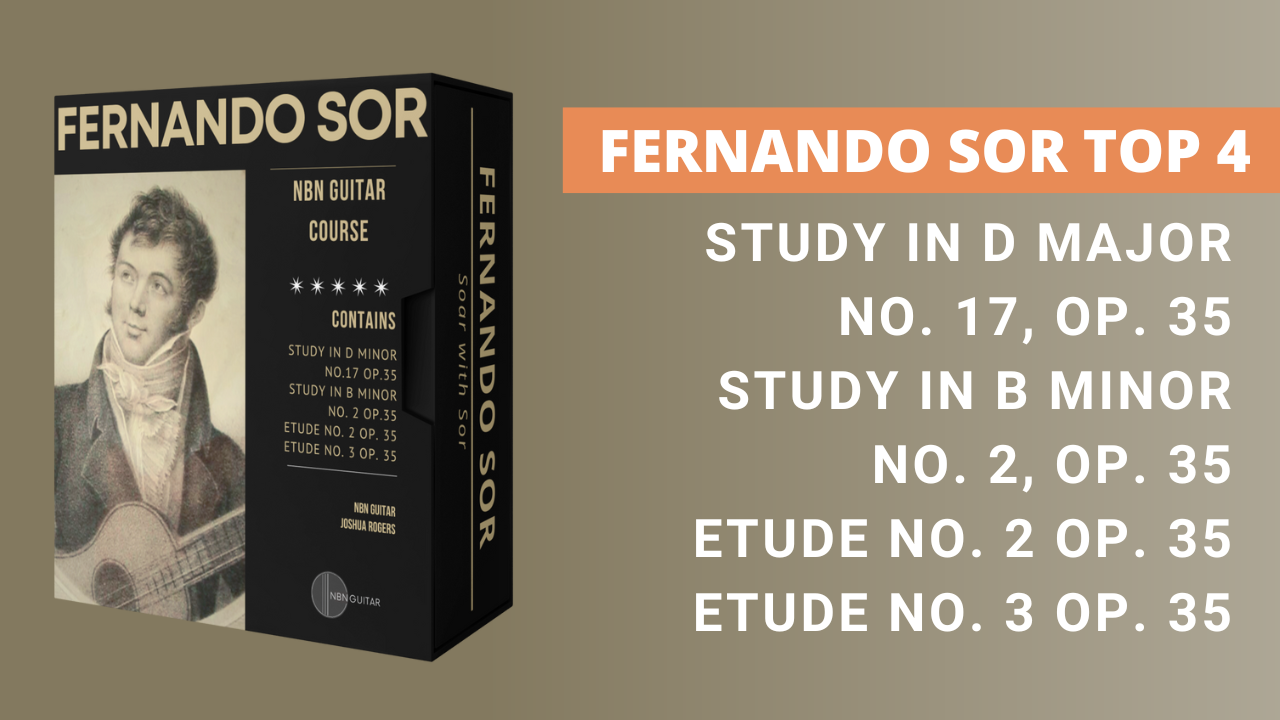Study in B Minor No. 2, Op. 35 by Fernando Sor
Introduction to Study in B minor Guitar Course
I recall hearing Julian Bream stating this piece was the first piece that he ever played in public. Apparently Julian and his father were attending a classical guitar society concert and Julian was asked to play a piece and he promptly played this one to the delight of all those in attendance. He also mentioned that many of the other players were very amateurish and suffered terribly from nerves!
“Study in B minor” by Fernando Sor is a compelling piece for classical guitar that beautifully blends technical demands with expressive depth. This study is set in the key of B minor and is typically performed at a moderate tempo, around 60-80 BPM. The piece features a lyrical melody supported by rich harmonic textures, creating a melancholic and introspective mood. It remains in B minor throughout, providing a consistent tonal framework. The composition includes intricate fingerings and arpeggiated patterns, which are designed to develop right-hand finger independence and left-hand agility. The piece’s structure emphasises melodic expression, making it a valuable study for guitarists seeking to enhance their technical proficiency and musical sensitivity.
Playing “Study in B minor” requires a refined technique and a deep understanding of its emotional nuances. The guitarist must focus on delivering smooth legato lines and maintaining clarity in the arpeggios. Attention to dynamics and phrasing is crucial to convey the piece’s expressive character, capturing the essence of Sor’s musical intentions.
I have played many of Sor’s pieces including the famous Variations on a Theme by Mozart, Op. 9 as one of my end of year recital pieces when I was a student at Victoria university in Wellington, New Zealand.
Musical Style
Fernando Sor’s musical style is characterised by its blend of Classical elegance and Romantic expressiveness. His compositions often feature clear, structured forms with an emphasis on melody and harmony. Sor’s works are known for their technical demands and lyrical beauty, making them essential repertoire for classical guitarists. His use of arpeggios, scales, and intricate fingerings not only enhances the guitarist’s technical skills but also provides a platform for expressive interpretation. Sor’s contributions to the classical guitar repertoire have had a lasting impact, influencing generations of guitarists with his innovative and musically rich compositions.
Notable Pieces
Five notable pieces by Fernando Sor:
• Etude in E minor, Op. 6, No. 11
• Grand Solo, Op. 14
• Introduction and Variations on a Theme by Mozart, Op. 9
• Minuet in D, Op. 11, No. 5
• Variations on a Theme by Mozart, Op. 9
Let your fingers fly!
Josh
Course Instructor
Study in B Minor Course
About this Course
Introduction to Study in B minor Guitar Course
I recall hearing Julian Bream stating this piece was the first piece that he ever played in public. Apparently Julian and his father were attending a classical guitar society concert and Julian was asked to play a piece and he promptly played this one to the delight of all those in attendance. He also mentioned that many of the other players were very amateurish and suffered terribly from nerves!
“Study in B minor” by Fernando Sor is a compelling piece for classical guitar that beautifully blends technical demands with expressive depth. This study is set in the key of B minor and is typically performed at a moderate tempo, around 60-80 BPM. The piece features a lyrical melody supported by rich harmonic textures, creating a melancholic and introspective mood. It remains in B minor throughout, providing a consistent tonal framework. The composition includes intricate fingerings and arpeggiated patterns, which are designed to develop right-hand finger independence and left-hand agility. The piece’s structure emphasises melodic expression, making it a valuable study for guitarists seeking to enhance their technical proficiency and musical sensitivity.
Playing “Study in B minor” requires a refined technique and a deep understanding of its emotional nuances. The guitarist must focus on delivering smooth legato lines and maintaining clarity in the arpeggios. Attention to dynamics and phrasing is crucial to convey the piece’s expressive character, capturing the essence of Sor’s musical intentions.
I have played many of Sor’s pieces including the famous Variations on a Theme by Mozart, Op. 9 as one of my end of year recital pieces when I was a student at Victoria university in Wellington, New Zealand.
Musical Style
Fernando Sor’s musical style is characterised by its blend of Classical elegance and Romantic expressiveness. His compositions often feature clear, structured forms with an emphasis on melody and harmony. Sor’s works are known for their technical demands and lyrical beauty, making them essential repertoire for classical guitarists. His use of arpeggios, scales, and intricate fingerings not only enhances the guitarist’s technical skills but also provides a platform for expressive interpretation. Sor’s contributions to the classical guitar repertoire have had a lasting impact, influencing generations of guitarists with his innovative and musically rich compositions.
Notable Pieces
Five notable pieces by Fernando Sor:
• Etude in E minor, Op. 6, No. 11
• Grand Solo, Op. 14
• Introduction and Variations on a Theme by Mozart, Op. 9
• Minuet in D, Op. 11, No. 5
• Variations on a Theme by Mozart, Op. 9
Let your fingers fly!
Josh




